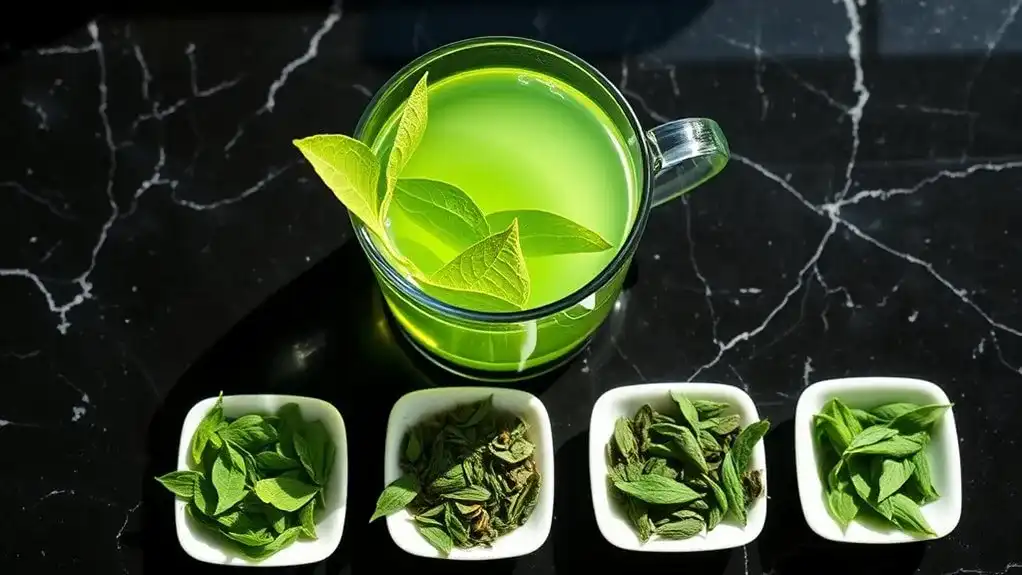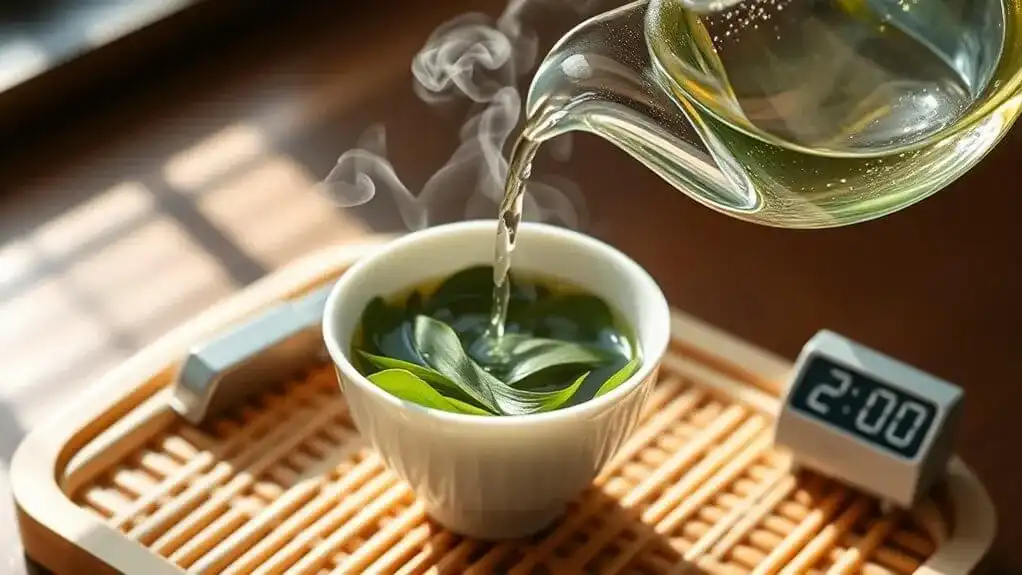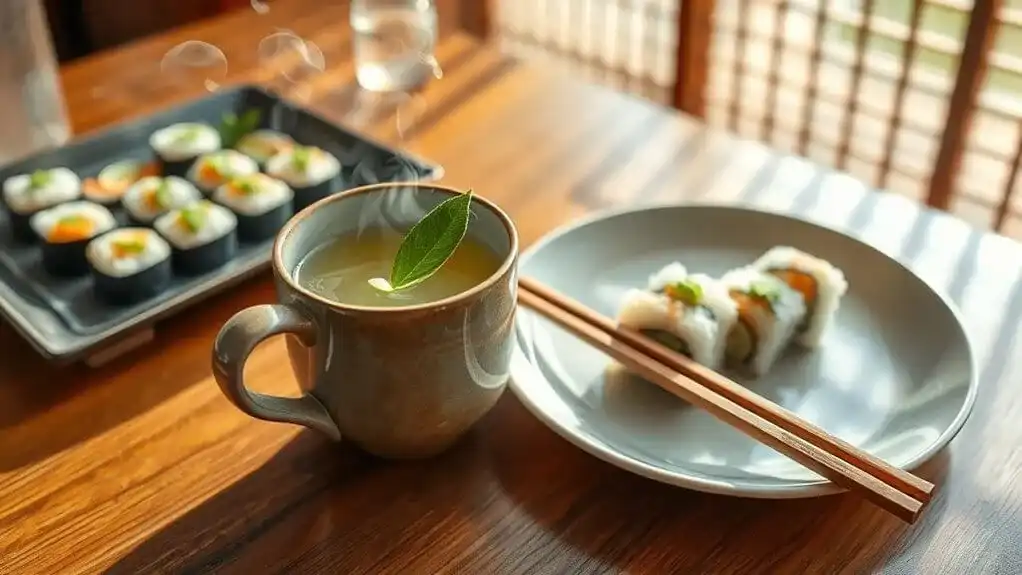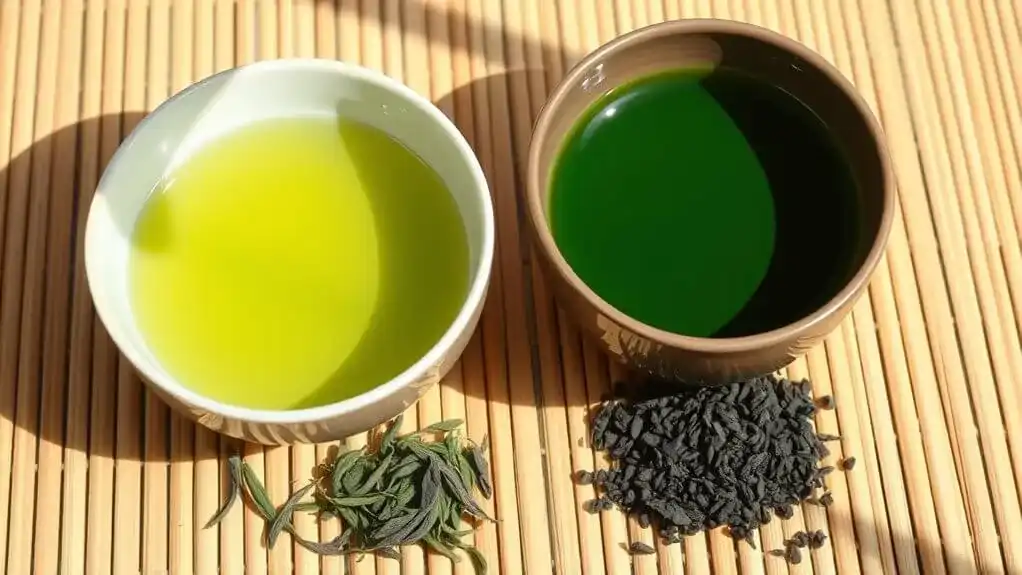Quality green tea reveals itself through distinct characteristics that anyone can spot. The leaves should display uniform, dark green coloring with consistent size and shape. Fresh, whole leaves produce clear liquor and deliver clean, crisp aromas with sweet, floral notes. Premium varieties won't taste bitter or musty, instead offering layers of grassy, vegetal, and umami flavors. Understanding these key indicators helps tea enthusiasts make informed purchases and access the full potential of their brew.
Key Points
- Look for uniform, whole leaves with rich green coloring and minimal powder or broken pieces at the bottom.
- Quality green tea leaves should feel light, delicate, and flexible when wet, with consistent texture throughout.
- Fresh tea should have clean, crisp aromas with sweet floral notes, without musty or stale smells.
- Premium green tea produces clear liquor with balanced flavors, avoiding quick bitterness or overwhelming astringency.
- Choose retailers offering transparent origin information and visual inspection opportunities for loose leaves before purchase.
What Makes Green Tea Worth Your Money
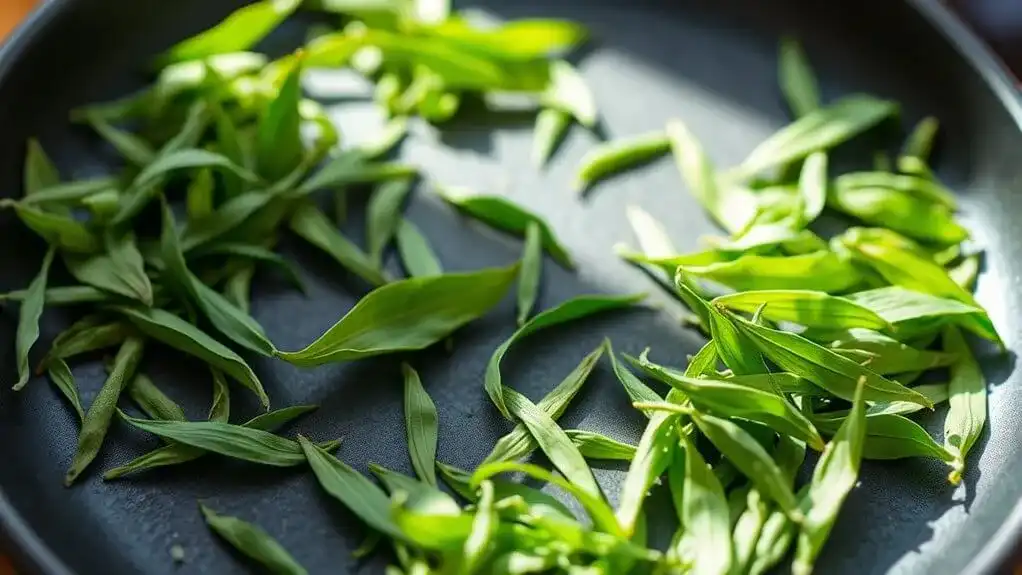
When you're investing in high-quality green tea, several key factors justify the higher price point. Premium teas are often hand-harvested, ensuring only the finest leaves make it into your cup. The careful production process, including proper shading and minimal processing, preserves the tea's natural health benefits and complex flavors. For optimal selection, shoppers can rely on trustworthy online retailers that provide detailed product information and clear images of the tea. Regular consumption can reduce stroke risk by up to 24% when drinking 2-4 cups daily. Tea ceremonies in Japan emphasize mindful consumption while drinking.
High-quality green tea delivers superior taste and aroma, with smooth, bright notes that persist through multiple brewing techniques. It's rich in antioxidants like EGCG and contains L-theanine, which supports cognitive function and heart health. The tea's origin, including the farm's soil quality and fertilization methods, plays an essential role in its overall value. While premium green tea costs more, its enhanced flavor profile, proven health benefits, and sustainable production methods make it a worthwhile investment for discerning tea enthusiasts.
Visual Clues of Premium Green Tea
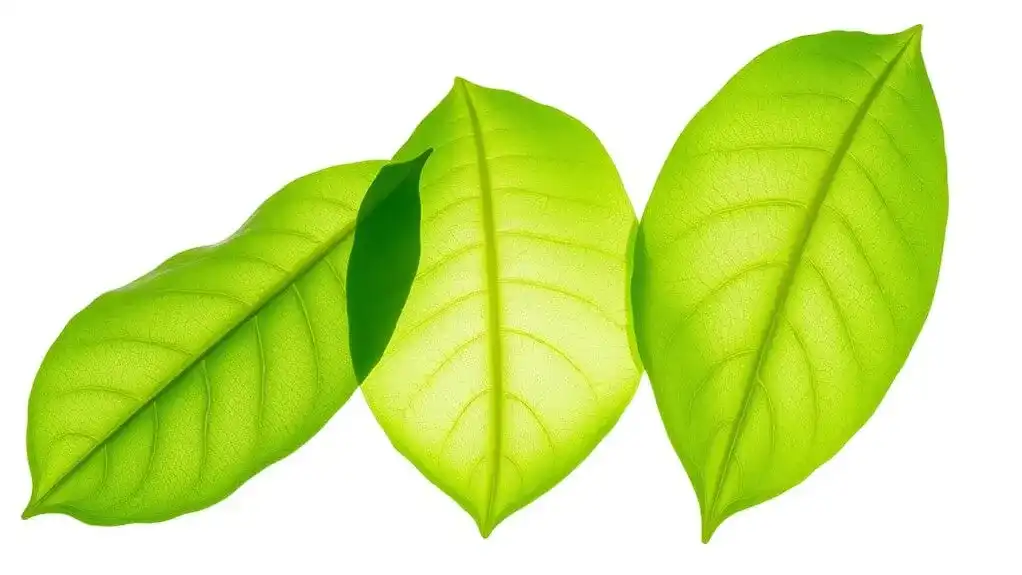
A keen eye can spot premium green tea through several distinctive visual characteristics. The leaf color should display rich, dark green hues in Japanese varieties, while leaf uniformity plays an essential role in determining quality across all types. Premium leaves maintain consistency in both shape and size, showing careful processing and selection. Much like navigating vast data, assessing tea quality requires careful attention to detail across multiple characteristics. Premium green tea generally uses first flush leaves harvested in early spring for optimal flavor and appearance.
When examining green tea, look for these key indicators:
- Fresh, vibrant leaves with a natural green to yellow appearance
- Thin, needle-like shapes in Japanese teas, or distinctly rolled styles in Chinese varieties
- Consistent size and shape throughout the batch
The tea liquor itself reveals quality through its clarity and light body. Premium Japanese teas, often made from the Yabukita cultivar, typically produce a brighter, cleaner profile with mild astringency and complex vegetal notes. The intense green color comes from abundant chlorophyll content, particularly noticeable in shade-grown varieties like Gyokuro.
The Touch and Feel Test
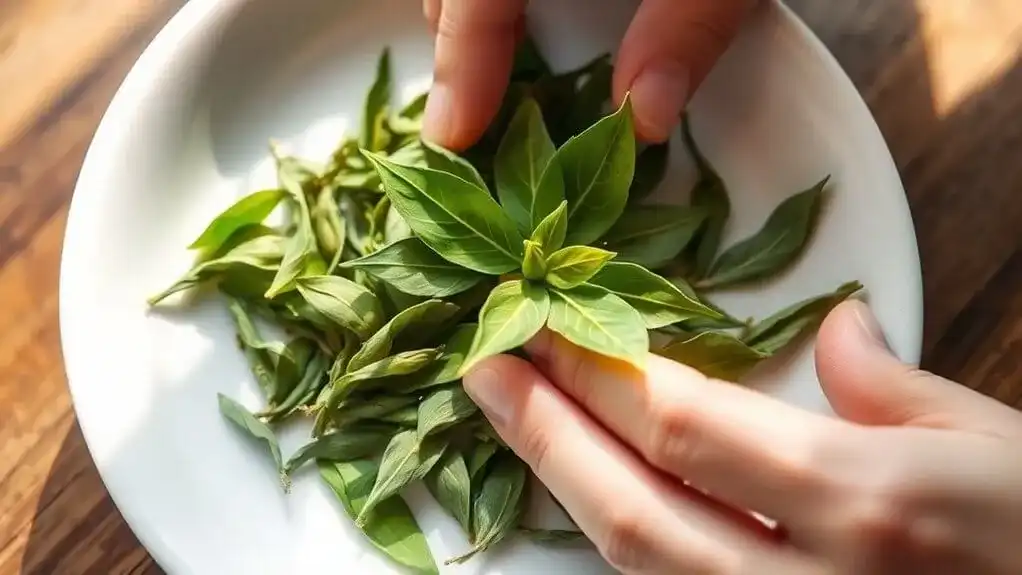
Testing green tea's quality extends beyond visual inspection to include vital tactile evaluation. Quality leaves should feel light and delicate when dry, with a well-twisted appearance that indicates proper processing. The texture evaluation of dry leaves can reveal significant clues about harvest timing and production standards.
When wet, leaf pliability becomes a key indicator. High-quality leaves should feel soft and flexible after soaking, never brittle or excessively slimy. This evaluation method is particularly important for matcha, where texture and fineness can vary significantly between grades. The touch test works best when performed consistently, using a standard amount of leaves under uniform conditions. It's often done alongside visual assessments for a thorough quality check. Using steaming water rather than boiling temperatures helps preserve the optimal texture during evaluation.
Premium green tea will maintain consistent texture throughout the batch, while variations might signal quality issues. This hands-on approach helps buyers make informed decisions about their tea purchases.
Understanding Aromas and Scents
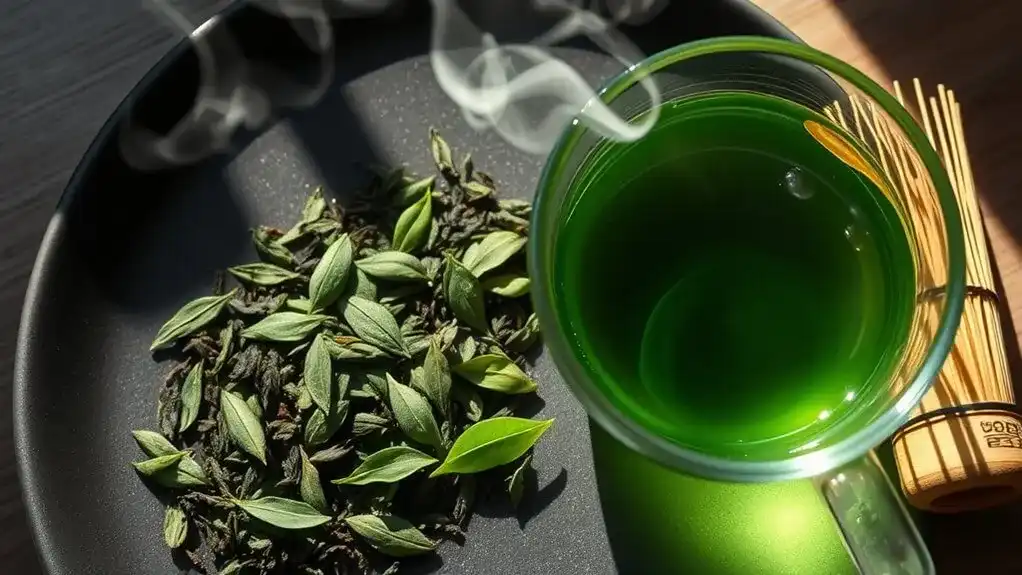
The complex world of green tea aromas offers a fascinating glimpse into its quality and character. While black teas boast around 600 aroma compounds, green tea contains over 200 unique scent profiles that contribute to its distinctive character. Modern perfumes have embraced green tea for its natural elegance in fragrance compositions. Recent studies show that medium-light exposure during leaf processing produces the highest quality aromatic compounds. The aroma classification of quality green tea reveals a delicate balance of compounds that create its signature freshness. The sassei process is crucial in preserving these distinctive aromas through careful steaming and heating of fresh leaves.
Key scent profiles to look for:
- Clean, crisp notes with earthy undertones
- Fresh young leaf scents combined with subtle roasted elements
- Sweet, floral hints reminiscent of lily of the valley and rose
Each aroma compound plays a vital role, from geraniol's rose-like scent to pyrazine's roasted notes. The early heating process in green tea production preserves these delicate aromas, ensuring they remain fresh and vibrant in the final product.
Tasting Notes That Matter
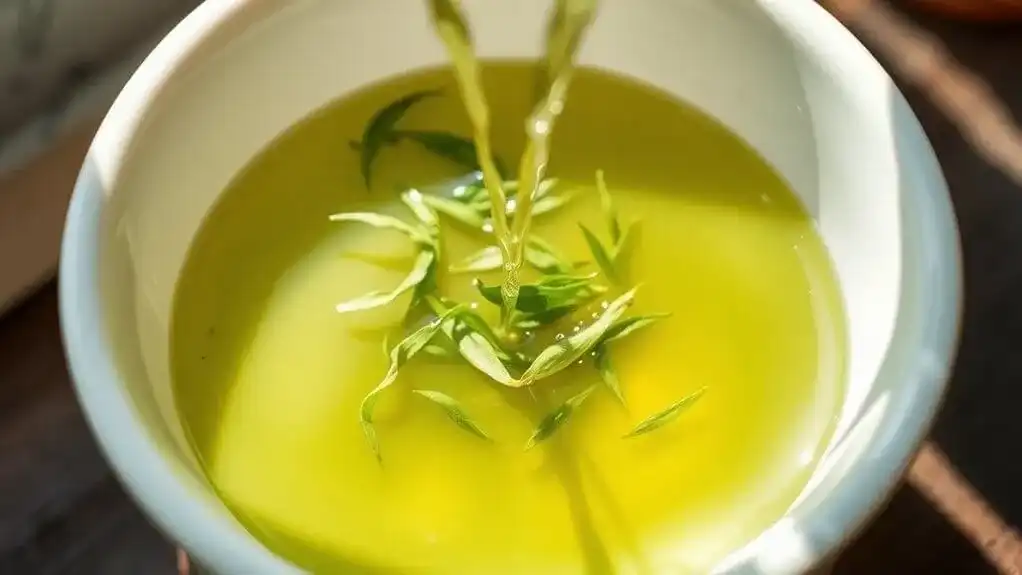
While aroma sets the initial expectation, mastering green tea's tasting notes elevates the entire experience to a new level. When applying proper tasting techniques, quality green tea reveals distinct layers of flavor that unfold with each sip, from grassy and vegetal to sweet and umami notes. Pure whole leaves contribute to a superior tasting experience with more nuanced flavors. Tea lovers recognize that shading duration directly impacts the level of sweetness in their cup.
The best flavor profiles exhibit clarity without muddled tastes or overwhelming bitterness. Premium green teas like Gyokuro offer marine notes, while Fukamushi Sencha delivers steamed vegetable flavors. What truly sets exceptional green tea apart is its balance – the harmonious interplay between sweetness, astringency, and other characteristics. The finish should be clean and lingering, leaving a pleasant aftertaste that doesn't overpower. These qualities reflect both the tea's origin and the precision of its processing methods.
Origins and Processing Methods
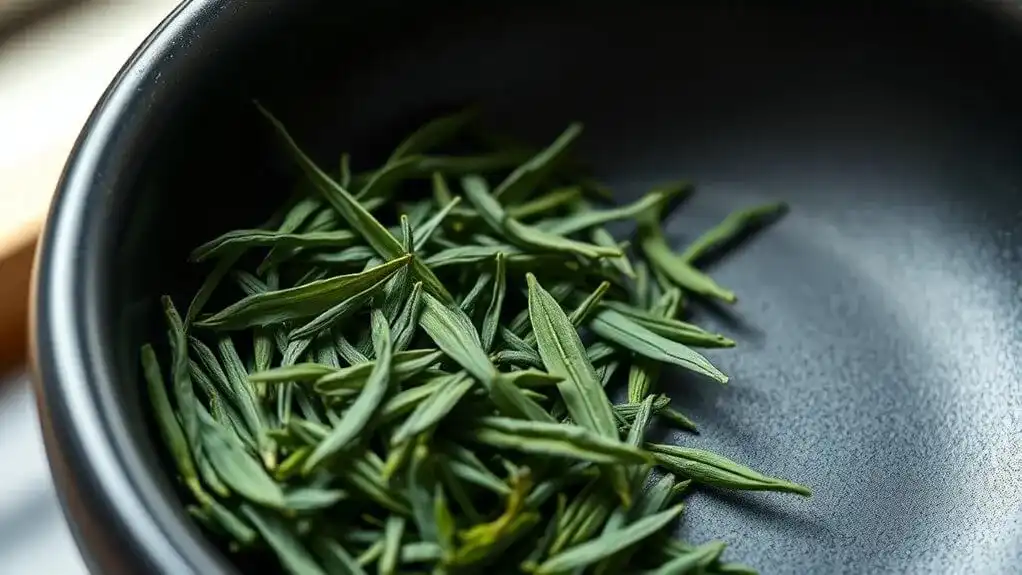
Dating back over 3000 years to ancient China, green tea's rich heritage began when Emperor Shennong supposedly discovered it after tea leaves fell into his boiling water. Its historical evolution from simple leaf chewing to sophisticated processing methods reflects its growing cultural significance across Asia, particularly during China's Tang Dynasty.
Today's quality green tea relies on precise processing techniques that have been refined over centuries:
- Initial steaming or pan-firing to halt oxidation and preserve the tea's vibrant green color
- Strategic rolling techniques to shape the leaves and enhance brewing potential
- Careful drying to remove moisture while maintaining flavor compounds
The highest quality green teas undergo minimal oxidation compared to other tea varieties. Japanese tea masters revolutionized production in the 18th century by introducing mechanical processes, while Chinese producers often combine steaming with pan-firing to achieve distinct flavor profiles. Modern India has emerged as a significant producer, with regions like Darjeeling and Assam creating distinctive green tea varieties. The tea's formal preparation became a significant social convention by the 5th century CE, marking its integration into daily Chinese life.
Red Flags to Watch For
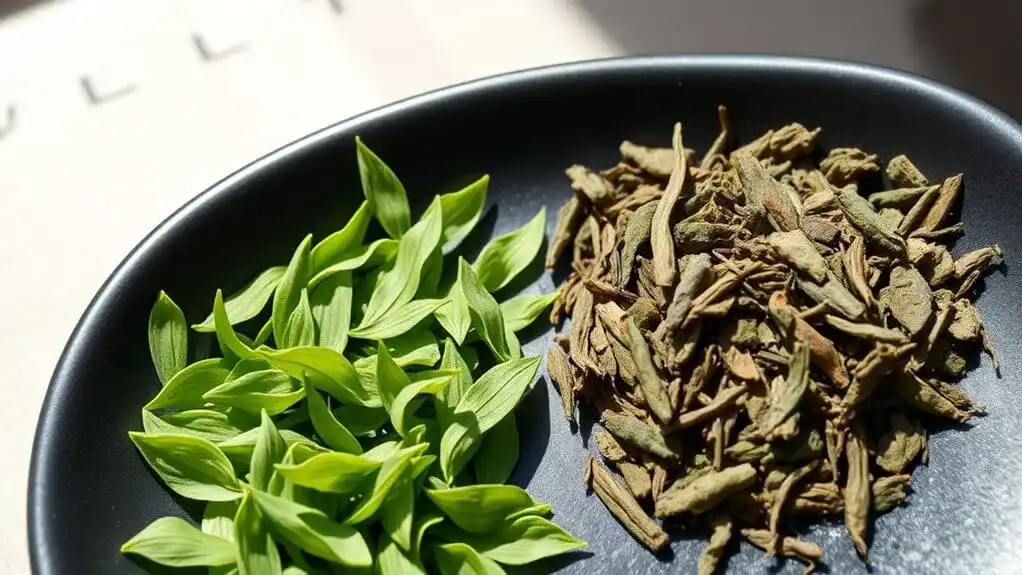
Although experienced tea enthusiasts can spot quality green tea instantly, several red flags help newcomers identify subpar products before making a purchase. When examining leaf quality, watch for unevenly sized leaves, dull coloring, and excessive powder, which often indicate poor processing. Premium quality green teas produce thick, creamy foam when properly whisked. Low-quality teas frequently hide behind tea bags and powdered forms, masking fillers and artificial additives. Tea producers historically used broken leaf forms to maximize shipping density when transporting tea to European markets. The aroma becomes most revealing when you examine wet tea leaves rather than just the dry form.
During brewing techniques, pay attention to how quickly bitterness and astringency develop, as these traits typically signal broken leaves and inferior processing. Quality green tea should deliver a balanced flavor profile without musty aromas or artificial notes. Be wary of products that lack visual inspection opportunities, clear origin information, or proper certifications. Reputable brands always provide transparency about their processing methods and sourcing practices.
Price vs. Quality Reality Check
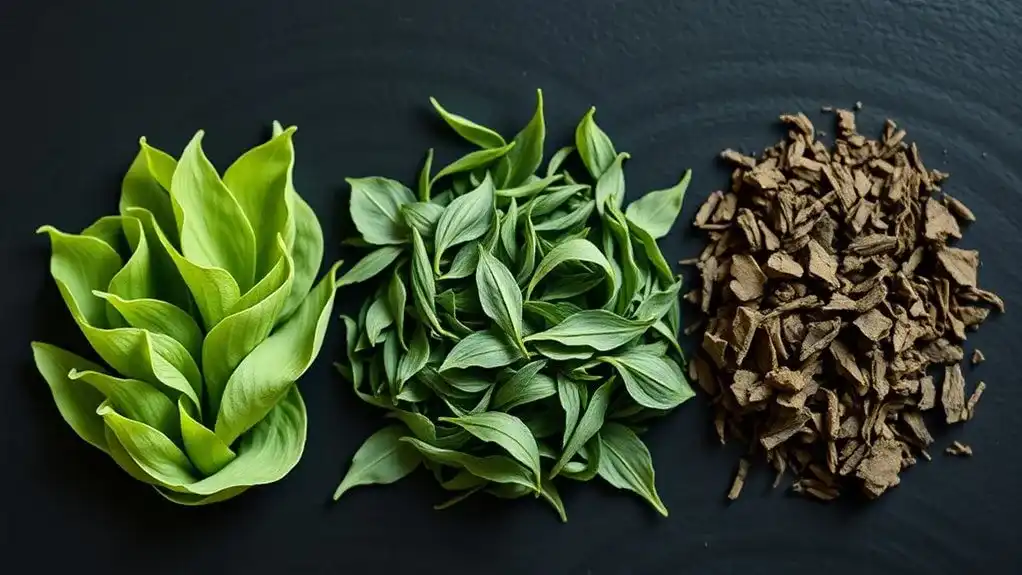
Since high-quality green tea often demands premium prices, understanding the relationship between cost and quality helps consumers make informed decisions. While cost perception often aligns with quality expectations, several factors influence pricing beyond just quality, including brand recognition, distribution channels, and marketing strategies. Tea produced at high elevations typically commands higher prices due to its superior quality characteristics. Organic cultivation methods yield teas with cleaner flavors due to the absence of synthetic chemicals. Research shows that tea stored at 20°C maintains optimal quality for extended periods.
- Premium prices typically reflect labor-intensive cultivation methods, careful processing techniques, and ideal storage conditions
- Higher costs may indicate superior chemical composition, including elevated catechin levels and antioxidant activity
- Geographic location and climate conditions of tea gardens contribute to both quality and pricing
Consumers should note that while price can be a quality indicator, it's not the sole determining factor. Some excellent teas may be reasonably priced due to direct distribution channels, while certain expensive options might simply reflect heavy marketing investments rather than superior quality.
Where to Buy High-Quality Green Tea
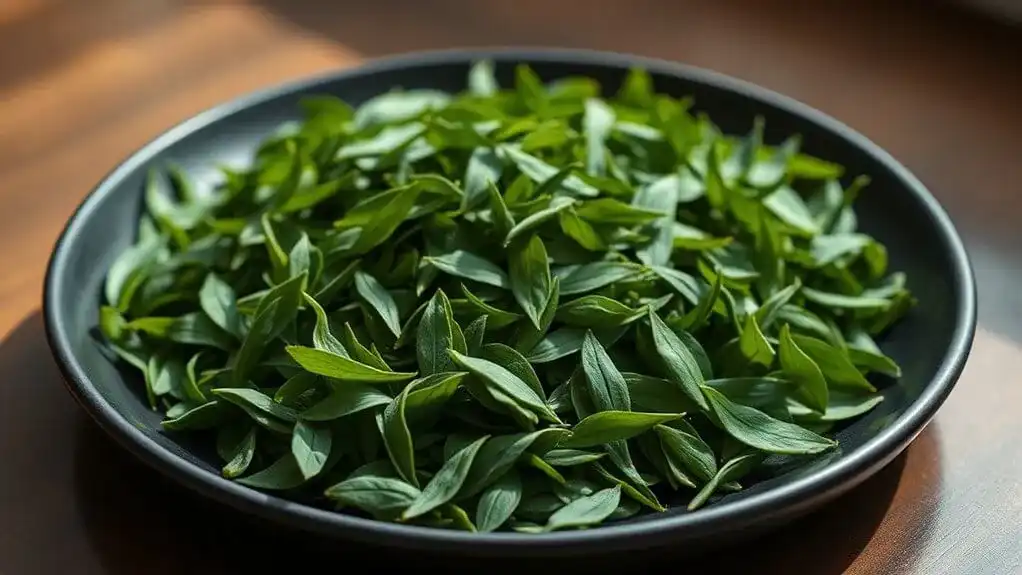
With numerous vendors offering green tea, finding reliable sources for high-quality leaves requires careful consideration. Local health food stores provide accessible options, though buyers should carefully inspect loose leaves and seek specific cultivars for better quality. Retailers who offer small batch production typically deliver superior tea experiences. Specialty shops prioritize meticulous selection to ensure premium quality for tea enthusiasts.
Major retailers like Walmart stock trusted brands including TAZO and Bigelow for reliable quality. For those seeking specialized selections, online retailers like Upton Tea deliver competitive prices and detailed product information. Their lightweight shipments make ordering convenient and cost-effective. Japanese-focused vendors such as Nio Teas excel in offering region-specific varieties and emphasize freshness through recent packaging dates.
These buying tips extend to high-end shops like Davidson's Teas, which balance quality with competitive pricing. Whether shopping locally or online, consumers benefit from vendors who provide thorough product details, clear sourcing information, and various purchasing quantities to suit different needs.
Conclusion
Like Odysseus steering between Scylla and Charybdis, finding quality green tea requires careful guidance through a sea of options. Armed with knowledge of visual cues, texture, aroma, and taste markers, you're now equipped to make informed choices. Remember that price isn't always the best indicator – it's the combination of origin, processing, and freshness that reveals a tea's true character. Trust your senses and enjoy the journey.
